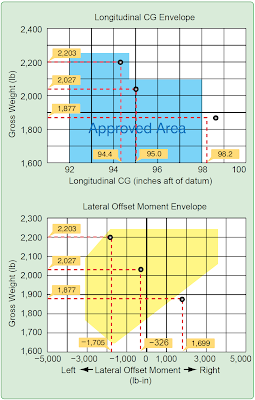Weight and balance considerations of a helicopter are similar to those of an airplane, except they are far more critical, and the center of gravity (CG) range is much more limited. [Figures 1 and 2] The engineers who design a helicopter determine the amount of cyclic control authority that is available, and establish both the longitudinal and lateral CG envelopes that allow the pilot to load the helicopter so there is sufficient cyclic control for all flight conditions.
 |
| Figure 1. Weight and balance data needed to determine proper loading of a helicopter |
 |
| Figure 2. Typical helicopter datum, flight stations, and butt line locations |
If the CG is ahead of the forward limit, the helicopter tilts and the rotor disk has a forward pull. To counteract this and maintain a stationary position, rearward cyclic stick displacement would be required. If the CG is too far forward, there may not be enough available cyclic authority to allow the helicopter to flare during landing, and it consequently requires an excessive landing distance.
If the CG is aft of the allowable limits, the helicopter flies with a tail-low attitude and may need more forward cyclic stick displacement than is available to maintain a hover in a no-wind condition. There might not be enough cyclic travel to prevent the tail boom from striking the ground. If gusty winds should cause the helicopter to pitch up during high speed flight, there might not be enough forward cyclic control to safely lower the nose.
Lateral balance of an airplane is usually of little concern and is not normally calculated. Some helicopters, especially those equipped for hoist operations, are sensitive to the lateral position of the CG and their Pilot’s Operating Handbook/Rotorcraft Flight Manual (POH/RFM) include both longitudinal and lateral CG envelopes, as well as information on the maximum permissible hoist load. Figure 3 is an example of such CG envelopes.

